Introduction:
Assessing the maturity of a business is essential in understanding its current state and making informed decisions about future growth. The maturity of a business can be assessed in stages, which can vary depending on the industry and the specific needs of the business. In this article, we will discuss the four stages of business maturity, from Basic to NextGen.

Stage 1 – Basic:
In this stage, the business is struggling to survive. It may have just started and is still developing its product or service, building its team, and securing funding. It may be an established business that is encountering difficult challenges. The business may not have a clear plan or strategy. The focus is on establishing a foundation for the business to build upon. The business may face challenges such as limited financial resources, lack of brand recognition, and difficulty acquiring new employees, customers, or suppliers.
To move beyond this stage, the business needs to focus on developing its product or service, building or rebuilding a strong team, and creating a sustainable business model. The business needs to establish clear goals and objectives and develop a strategy for achieving them.
Stage 2 – Stable:
In this stage, the business has met the industry sector standards. It is keeping up with most of its competitors. It has established a stable customer base and a reliable revenue stream. The business is expanding and increasing its revenue by improving its product or service, building a strong brand, and implementing effective marketing and sales strategies. The focus is on maintaining the momentum and improving operational efficiency.
To move beyond this stage, the business needs to focus on innovation and differentiation. It needs to develop new products or services and expand into new markets. The business needs to improve its competitive position and continue to grow its customer base.
Stage 3 – Advanced:
In this stage, the business is a leader in its industry sector. It has a strong market presence and has established itself as a trusted brand. The business is beginning to expand rapidly and is continuously innovating its products or services. The focus is on maintaining a competitive edge, building strategic partnerships, and exploring new opportunities for growth.
To move beyond this stage, the business needs to continue to innovate and expand. It needs to explore new markets and leverage its competitive advantage. The business needs to establish itself as a thought leader in its industry sector and drive industry-wide change.
Stage 4 – NextGen:
In this stage, the business is leading its industry sector to new frontiers. It has established itself as a disruptive force and is driving innovation and change across the industry. The business is expanding into new markets, exploring new technologies, and redefining the industry standard. The focus is on driving growth, creating new revenue streams, and shaping the future of the industry.
To continue to thrive in this stage, the business needs to continue to push the boundaries of innovation and explore new opportunities for growth. The business needs to be agile and adaptable, able to respond quickly to changing market conditions and industry trends. The business needs energized ideas to continue to lead by example and drive industry-wide change.
Conclusion:
Assessing the maturity of a business is crucial for making informed decisions about its growth and success. The four stages of business maturity – Basic, Stable, Advanced, and NextGen – provide a framework for evaluating the current state of a business and identifying areas for improvement. Whether the business is struggling to survive or leading its industry to new frontiers, understanding its maturity stage can help guide strategic decisions and drive growth. By focusing on innovation, differentiation, and building strategic partnerships, businesses can move beyond the Stable stage and become Advanced or NextGen leaders in their industry sectors.

